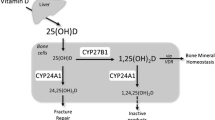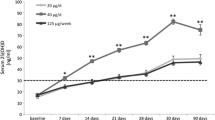Summary
A series of analogs of 1α,25-dihydroxyvitamin D3[1,25(OH)2D3] with alkyl substitutions in 26- and 27-positions were tested for calcium (Ca) regulating activity. The potencies of dialkyl analogs in stimulating bone resorption in neonatal mouse calvaria cultures were the highest in 1α,25-dihydroxy-26,27-dimethylvitamin D3[1,25(OH)2-(Me)2D3], followed by 1,25(OH)2D3, 1α,25-dihydroxy-26,27-diethylvitamin D3[1,25(OH)2(Et)2D3], and 1α,25-dihydroxy-26,27-dipropylvitamin D3[1,25(OH)2(Pr)2D3] in that order. A similar order of potential regarding formation of osteoclast-like cells in mouse bone marrow cell cultures and on bone Ca mobilization with long-term vitamin D-deficient rats was observed in the same series. The relative potencies of 1,25(OH)2D3, 1,25(OH)2(Me)2D3, 1,25(OH)2(Et)2D3, and 1,25(OH)2(Pr)2D3 in competing with 1,25(OH)2D3 for binding to chick intestinal cytosol receptors were 1:1:0.16:0.036. A similar order of potential in case of intestinal Ca transport in situ was observed in the same series. The potencies of dialkyl analogs in competing with 25-hydroxy-vitamin D3 for binding to rat serum vitamin D binding protein were much lower than that of 1,25(OH)2D3. Effect of 1,25(OH)2(Me)2D3 on osteopenia in rats induced by ovariectomy and right sciatic neurotomy was higher than that of 1,25(OH)2D3. From these results, the lengthening by one carbon at 26- and 27-positions was shown to maintain the Ca regulatory activity of 1,25(OH)2D3.
Similar content being viewed by others
References
Okamoto S, Tanaka Y, DeLuca HF, Kobayashi, Ikekawa N (1983) Biological activity of 24,24-difluoro-1,25-dihydroxyvitamin D3. Am J Physiol 244:E159-E163
Tanaka Y, DeLuca HF, Kobayashi Y, Ikekawa N (1984) 26,26,26, 27,27,27-Hexafluoro-1,25-dihydroxyvitamin D3: a highly potent, long-lasting analog of 1,25-dihydroxyvitamin D3. Arch Biochem Biophys 229:348–354
Eguchi T, Sai H, Takatsuto S, Hara N, Ikekawa N (1988) Synthesis of 26,27-dialkyl analogues of 1α,25-dihydroxyvitamin D3. Chem Pharm Bull 36:2303–2311
Eguchi T, Ikekawa N, Sumitani K, Kumegawa M, Higuchi S, Otomo S (1990) Effect on carbon lengthening at the side chain terminal of 1α,25-dihydroxyvitamin D3 for calcium regulating activity. Chem Pharm Bull 38:1246–1249
Shigeno C, Yamamoto I, Dokoh S, Hino M, Aoki J, Yamada K, Morita R, Kaneyama M, Torizuka K (1985) Identification of 1,24(R)-dihydroxyvitamin D3-like bone resorbing lipid in a patient with cancer-associated hypercalcemia. J Clin Endocrinol Metab 61:761–768
Takahashi N, Yamana H, Yoshiki S, Roodman GD, Munday GR, Jones ST, Boyde A, Suda T (1988) Osteoclast-like cell formation and its regulation by osteotropic hormones in mouse bone marrow cultures. Endocrinology 122:1373–1382
Burstone MS (1958) Histochemical demonstration of acid phosphatase with naphthol AS-phosphates. J Natl Cancer Inst 21:523–539
Suda T, DeLuca HF, Tanaka Y (1970) Biological activity of 25-hydroxyergocalciferol in rats. J Nutr 100:1049–1052
Connerty HV, Briggs AR (1966) Determination of serum calcium by means of orthocresolphthalein complexone. Am J Clin Pathol 45:290–296
Omdahl J, Holick MF, Suda T, Tanaka Y, DeLuca HF (1971) Biological activity of 1,25-dihydroxycholecalciferol. Biochemistry 10:2935–2940
Okumura H, Yamamuro T, Higuchi S, Harada M, Takamura T, Otomo S, Aihara H, Ikekawa N, Kobayashi (1990) 26,27-hexafluoro-1,25-dihydroxyvitamin D3(F6-1,25(OH)2D3) prevents osteoprosis induced by immobilization combined with ovariectomy in the rat. Bone Miner 9:101–109
Seino Y, Yamaoka K, Ishida M, Yabuuchi H, Ichikawa M, Ishige H, Yoshino H, Avioli LV (1982) Biochemical characterisation of 1,25-dihydroxyvitamin D receptor in chick embryonal duodenal cytosol. Calcif Tissue Int 34:265–269
Haddad JG, Chyu KJ (1971) Competitive protein-binding radioassay for 25-hydroxycholecalciferol. J Clin Endocrinol 33:992–995
Gill HS, Londowski JM, Corrodino RA, Zmsmeister AR, Kumar R (1988) The synthesis and biological activity of 25-dihydroxy-26,27-dimethylvitamin D and 1,25-dihydroxy-26,27-dimetylvitamin D: highly potent novel analogs of vitamin D. J Steroid Biochem 31:147–160
Author information
Authors and Affiliations
Rights and permissions
About this article
Cite this article
Miyahara, T., Harada, M., Miyata, M. et al. Calcium regulating activity of 26,27-dialkyl analogs of 1α,25-dihydroxyvitamin D3 . Calcif Tissue Int 51, 218–222 (1992). https://doi.org/10.1007/BF00334550
Received:
Revised:
Issue Date:
DOI: https://doi.org/10.1007/BF00334550




